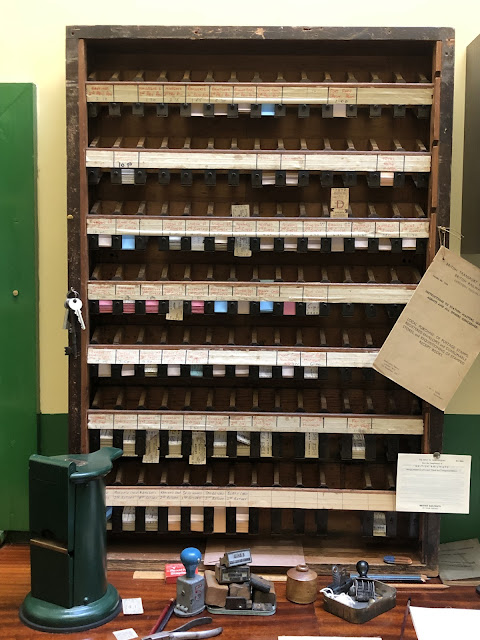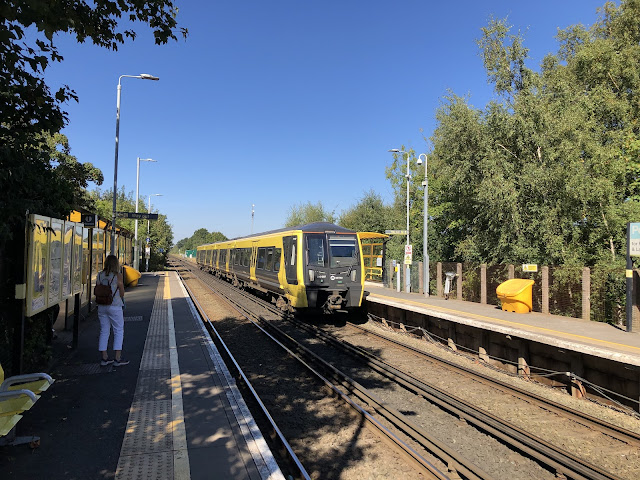Not for the first time, I sauntered along to Talisman
Railwayana Auctions at the Newark Showground. Talisman RA is effectively the
last man standing. Before 2020, all the dedicated railwayana auction houses
held regular live sales, so a choice of locations and opportunities to attend
came up every few weeks. Then Covid hit. To survive at all, the auctions went
online and that is where most of them have stayed. Amongst the most prominent
players, Talisman now stands alone, with live events remaining as their mainstay.
For this, Roger and Sandra Phipps deserve great credit for their perseverance after
difficult times and for recognising the importance of the theatre that the live
auction provides. There is a slice of humanity in that hall that can’t be
replicated online.
The pandemic appears to me to have had quite an effect on some
of the other railwayana auction houses. Of course, they would all have
benefited from the reduced overheads by not having to stage live events. My
guess is that the clarity and visual appeal of the websites has become even more
significant than it was before. This is the way that the world views them now.
The online presence has got to be good. In the case of GW Railwayana Auctions,
for example, it is excellent. Cover of what is on offer is comprehensive,
auction result history readily accessible, overall presentation and navigation
around the site first class.
For many years up until the pandemic, I met up with my
friend, John, at a convenient rendezvous point that lay between us geographically.
It gave us a chance for a general catch-up surrounded by the railway
paraphernalia of our youth. John’s background is in art and design and we share
an affection for many of the items of paperwork that reflect the prevalent
styles of the inter-war and post-war periods. The implication of the changes
mentioned above means that this is no longer an option for us, so for some time
now I have been going along by myself. It’s not quite the same. Indeed, I often
wonder why I’m here. I’m not really a true believer. I have a few railway
hardware items at home but not enough to call a collection, nor do I really
want one. I have acquired some paintings, posters and carriage prints over the
years but rarely add to my haul these days. I have no more wall space in my
office and so I can only reasonably replace what is already there. A degree of
inertia has set in. Yet I still look through the Talisman catalogue when it
drops on the mat and I pick out any personal highlights. The most appealing
this time was displayed across the front cover. It was a painting by the
well-regarded railway artist, John Austin. This painting of a Coronation Class
locomotive at speed is very attractive. It communicates power and speed
effectively, is technically very sound and is a great reminder of my favourite class
of steam engine.
I made sure I was at the auction in time to see it go. I
obtained a bidding card, even though I rarely bid for anything these days. I
told Chris I might have a go at it if I can have it as my Christmas present,
but I knew that to qualify for that it would have to be on offer at a bargain
price of no more than £400 at the hammer, with premiums to add. I positioned
myself with a clear view of the chair and the auctioneer started at £300. I
gripped my card, poised, but hidden behind my catalogue. Bidding shot quickly
to £500 and stopped there. I couldn’t justify it to myself to wade in at that
point. There was no guarantee that a further bid would be any more than a token
gesture and before I knew it we would have been at £600 and beyond. In that
moment, time suddenly rushes by. It can be a weird experience, especially for
us part-timers.
I know it sounds weak-kneed but that actually sums up my
attitude to the whole thing. I have to feel I’ve got a bargain, so I inevitably
price myself out of the running. So be it. I’ve never felt that I was totally
on board with it. I’m neither in, nor out. I don’t know anyone else present,
yet so many people seem to know each other well and the chairman seems to know
half of the serious collectors by their first name. I’ve been going along for
years and years yet I still feel like I’m an interloper, only peripherally part
of the set-up, wafting around at the margins.
This is certainly a very distinctive sub-culture - very
male, very white and very old. I suspect that it is composed almost entirely of
a cohort of trainspotters who grew up in the 50s and 60s. They are boys who
happened to share the same hobby and who just won’t let it go because it has
come to characterise how they see themselves ever since. Kate Fox, the author
of the book, Watching the English, would have a field day here.
I wonder if it’s really just all about permanence and
impermanence. The stuff stays exactly the same but we grow old then leave it
behind. Additionally, there is substantial knowledge and expertise on view
here. There is also real friendship and fellowship encouraged by a common
cause. Our railway heritage has been shattered into pieces and then reassembled
in a jumble and out of context in this place, but the fragments are rightly
being treasured all the same. It encompasses multitudes of designs from
different but recognisable eras, innovative artwork of its time and vast
quantities of skilled engineering and carpentry products. It represents decades
(now nearly centuries, in fact) of development in craftsmanship, now all superseded
by the digital age, modern materials and replacement fabrication techniques.
I’d had enough after about an hour and a half. I’d obviously
had my fix. I’d toured the unchanging side stalls staffed by the same faces as
before and found nothing that grabbed my attention. After lunch another copy of
the New Brighton poster by Wilcox that I recently gave to my daughter and a
Wallasey Grove Road station totem were coming up. Mine is of Wallasey Village.
Surely this is from the same collection and belonged to a Wirralian, just like
me? This is how a part of me will eventually be disseminated for the benefit of
any takers, not that that matters. I will have had my enjoyment from them, too.
Covid changed the way this system operates but it’s still
strong and has survived, as most of us have. We just move in slightly different
ways, perhaps. When I approach anywhere that’s crowded, I may now reach for my
mask. I used it last on a crowded rush-hour London tube last month and its
always readily available in my jeans back pocket. In any environment, I now walk
away from anyone that’s coughing or sneezing, and I still hold my breath when
I’m close to an audible sniffler or a nose blower. Its not neurosis, its
conditioning. Its what we did to try to get through it, and for those close to
me it worked, as I had promised them that it would if we were careful.
I will no doubt remain ambivalent about my participation in
this rather obsessive world of railway memorabilia. Mostly, I don’t need to own
it to admire it or for it to serve as a reminder of good times. There’s greater
perspective there for me now, gained gradually by the passage of time. You
really can’t take it with you. I’m more like to sell some of the bits I’ve already
accumulated from now on, in order to afford that one special painting when it
appears, especially if no-one else can see why its so good and I can get it for
a bargain. Eyes still wide open and bidding card in hand.



















































